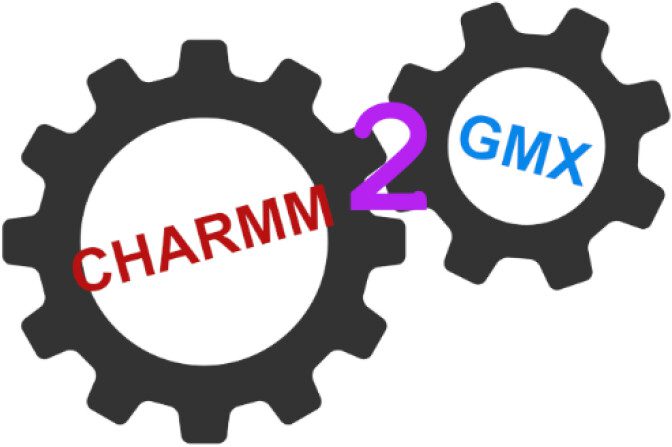Molecular mechanics (MM) calculations and molecular dynamics (MD) simulations are powerful tools used in biomolecular research, relying on accurate force fields (FFs) for reliable results. With the popularity of different simulation packages and the wide range of FFs available, researchers face the challenge of ensuring proper FF implementation in their chosen software. This article explores the widely used CHARMM FF and the GROMACS software, highlighting the complexities involved in porting the CHARMM FF to GROMACS and the need for a robust and automated conversion process.
The CHARMM FF is renowned for its versatility in biomolecular simulations, covering a wide range of entities, including proteins, nucleic acids, carbohydrates, lipids, and monatomic ions. On the other hand, GROMACS is a very optimized and adaptable software suite known for its quickness and simplicity. Implementing the CHARMM FF in GROMACS requires more than simple unit conversions, as there are philosophical differences between the two codes that need to be reconciled.
Challenges in Porting CHARMM to GROMACS
One of the challenges in porting CHARMM to GROMACS is the disparity between the powerful patching utility in CHARMM and the limited capacity of GROMACS’ topology building program, pdb2gmx, to generate polymer branch points or modifications to internal chain residues. Additionally, CHARMM’s modular organization, with parameter and topology files, further complicates the conversion process. Residue naming conflicts and the monolithic nature of FFs in GROMACS also require careful consideration during the porting process.
Previous attempts at porting CHARMM to GROMACS involved either manual hardcoding or partial conversions that lacked robustness and flexibility. While some utilities were useful for specific species or systems, they often failed to provide evidence of reliability. The CHARMM-GUI web server addressed this challenge by converting PSF (protein structure file) topology to GROMACS format, but it did not provide the entire FF, limiting flexibility for system modifications.
Introducing charmm2gmx: A Generalizable Solution
To overcome the limitations of previous approaches, the researchers developed charmm2gmx, an automated conversion utility written in Python. The aim was to minimize hardcoding and dependency on upstream data while ensuring the conversion process adhered closely to the conventions of the original FF release. By aggregating user input in a single input file, charmm2gmx ensures repeatability and self-documentation.
The charmm2gmx Workflow
Charmm2gmx follows a comprehensive workflow to ensure accurate and efficient conversion of the CHARMM FF to GROMACS. The process involves the analysis of CHARMM FF files, including parameter (.prm) and topology (.rtf) files, as well as additional residue definitions and parameter information contained in “stream” files (*.str). By analyzing and converting the original FF files rather than hardcoding data, charmm2gmx ensures flexibility and reduces the need for manual intervention during maintenance and updates.
To validate the effectiveness of charmm2gmx, extensive single-point energy analysis, and MD simulations were performed on various molecular systems. The results demonstrated that the automated conversion of FF files provided a reliable port of the CHARMM FF into the GROMACS format. This robust and user-friendly tool enables researchers to use the CHARMM FF seamlessly within GROMACS, facilitating broader utilization within the simulation community.
Future Applications
While charmm2gmx was primarily developed for the CHARMM FF, its underlying approach and heuristics can be extended to other FFs, making it a valuable resource for the scientific community. The utility’s compatibility with different FFs allows researchers to benefit from GROMACS’ optimized simulations while using their preferred FF. The availability of charmm2gmx under a permissive license encourages collaboration and the identification of potential improvements, ensuring the continued evolution of the conversion process.
Conclusion
The charmm2gmx utility provides a reliable and automated means of porting the CHARMM FF to the GROMACS software. By addressing the challenges associated with software differences and data organization, this tool enables researchers to seamlessly utilize the CHARMM FF within GROMACS, expanding the capabilities and options available for biomolecular simulations.
Story Source: Reference Paper | The charmm2gmx code, data, and scripts are available at Website
Learn More:
Dr. Tamanna Anwar is a Scientist and Co-founder of the Centre of Bioinformatics Research and Technology (CBIRT). She is a passionate bioinformatics scientist and a visionary entrepreneur. Dr. Tamanna has worked as a Young Scientist at Jawaharlal Nehru University, New Delhi. She has also worked as a Postdoctoral Fellow at the University of Saskatchewan, Canada. She has several scientific research publications in high-impact research journals. Her latest endeavor is the development of a platform that acts as a one-stop solution for all bioinformatics related information as well as developing a bioinformatics news portal to report cutting-edge bioinformatics breakthroughs.









